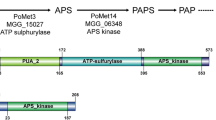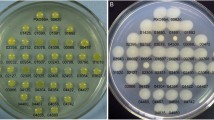Abstract
Rice blast caused by Magnaporthe oryzae severely impacts global rice yield stability. The rice endophyte Streptomyces sporocinereus OsiSh-2, with strong antagonistic activity towards M. oryzae, has been reported in our previous study. To decipher the model of the antagonistic action of OsiSh-2 towards M. oryzae, we compared the iron-capturing abilities of these two strains. The cultivation of OsiSh-2 and a M. oryzae strain under iron-rich and iron-starved conditions showed that M. oryzae depended more on iron supplementation for growth and development than did OsiSh-2. Genomic analysis of the S. sporocinereus and M. oryzae species strains revealed that they might possess different iron acquisition strategies. The actinobacterium OsiSh-2 is likely to favor siderophore utilization compared to the fungus M. oryzae. In addition, protein annotations found that OsiSh-2 contains the highest number of the siderophore biosynthetic gene clusters among the 13 endophytic actinomycete strains and 13 antifungal actinomycete strains that we compared, indicating the prominent siderophore production potential of OsiSh-2. Additionally, we verified that OsiSh-2 could excrete considerably more siderophores than Guy11 under iron-restricted conditions and displayed greater Fe3+-reducing activity during iron-supplemental conditions. Measurements of the iron mobilization between the antagonistic OsiSh-2 and Guy11 showed that the iron concentration is higher around OsiSh-2 than around Guy11. In addition, adding iron near OsiSh-2 could decrease the antagonism of OsiSh-2 towards Guy11. Our study revealed that the antagonistic capacity displayed by OsiSh-2 towards M. oryzae was related to the competition for iron. The highly efficient iron acquisition system of OsiSh-2 may offer valuable insight for the biocontrol of rice blast.





Similar content being viewed by others
References
Wilson RA, Talbot NJ (2009) Under pressure: investigating the biology of plant infection by Magnaporthe oryzae. Nat Rev Microbiol 7(3):185–195
Ebbole DJ (2007) Magnaporthe as a model for understanding host-pathogen interactions. Annu. Rev. Phytopathol. 45(1):437–456
Miah G, Rafii M, Ismail M, Puteh A, Rahim H, Asfaliza R, Latif M (2013) Blast resistance in rice: a review of conventional breeding to molecular approaches. Mol. Biol. Rep. 40(3):2369–2388
Gnanamanickam SS (2009) Biological control of rice diseases. Springer, Dordrecht, Netherlands
Xu T, Li Y, Zeng X, Yang X, Yang Y, Yuan S, Hu X, Zeng J, Wang Z, Liu Q (2017) Isolation and evaluation of endophytic Streptomyces endus OsiSh-2 with potential application for biocontrol of rice blast disease. J. Sci. Food Agric. 97(4):1149–1157
Araujo R, Kaewkla O, Franco CM (2017) Endophytic actinobacteria: beneficial partners for sustainable agriculture. Endophytes: Biology and Biotechnology
Su Z, Mao L, Li N, Feng X, Yuan Z, Wang L, Lin F, Zhang C (2013) Evidence for biotrophic lifestyle and biocontrol potential of dark septate endophyte Harpophora oryzae to rice blast disease. PLoS One 8(4):e61332
Keerthana U, Nagendran K, Raguchander T, Prabakar K, Rajendran L, Karthikeyan G (2017) Deciphering the role of Bacillus subtilis var. amyloliquefaciens in the management of late blight pathogen of potato, Phytophthora infestans. P Natl A Sci India B 2017:1–10
Dutta D, Puzari KC, Gogoi R, Dutta P (2014) Endophytes: exploitation as a tool in plant protection. Braz Arch Biol Techn 57(5):621–629
El-Tarabily K, Nassar A, Hardy GSJ, Sivasithamparam K (2009) Plant growth promotion and biological control of Pythium aphanidermatum, a pathogen of cucumber, by endophytic actinomycetes. J. Appl. Microbiol. 106(1):13–26
Cao L, Qiu Z, You J, Tan H, Zhou S (2005) Isolation and characterization of endophytic streptomycete antagonists of fusarium wilt pathogen from surface-sterilized banana roots. FEMS Microbiol. Lett. 247(2):147–152
Arias AA, Lambert S, Martinet L, Adam D, Tenconi E, Hayette M-P, Ongena M, Rigali S (2015) Growth of desferrioxamine-deficient Streptomyces mutants through xenosiderophore piracy of airborne fungal contaminations. FEMS Microbiol. Ecol. 91(7):1–9
Schaible UE, Kaufmann SH (2004) Iron and microbial infection. Nat Rev Microbiol 2(12):946–953
Haas H, Eisendle M, Turgeon BG (2008) Siderophores in fungal physiology and virulence. Annu. Rev. Phytopathol. 46:149–187
Loper JE, Henkels MD (1999) Utilization of heterologous siderophores enhances levels of iron available to Pseudomonas putida in the rhizosphere. Appl Environ Microb 65(12):5357–5363
O'sullivan DJ, O'Gara F (1992) Traits of fluorescent Pseudomonas spp. involved in suppression of plant root pathogens. Microbiol. Rev. 56(4):662–676
Traxler MF, Seyedsayamdost MR, Clardy J, Kolter R (2012) Interspecies modulation of bacterial development through iron competition and siderophore piracy. Mol. Microbiol. 86(3):628–644
Loper JE, Buyer JS (1991) Siderophores in microbial interactions on plant surfaces. Mol Plant Microbe In 4(1):5–13
Askwith C, Kaplan J (1997) An oxidase-permease-based iron transport system in Schizosaccharomyces pombe and its expression in Saccharomyces cerevisiae. J. Biol. Chem. 272(1):401–405
Homuth M, Valentin-Weigand P, Rohde M, Gerlach G-F (1998) Identification and characterization of a novel extracellular ferric reductase from Mycobacterium paratuberculosis. Infect. Immun. 66(2):710–716
Li J, Chi Z, Li H, Wang X (2008) Characterization of a mutant of Alteromonas aurantia A18 and its application in mariculture. J Ocean U China 7(1):55–59
Tierrafría VH, Ramos-Aboites HE, Gosset G, Barona-Gómez F (2011) Disruption of the siderophore-binding desE receptor gene in Streptomyces coelicolor A3 (2) results in impaired growth in spite of multiple iron-siderophore transport systems. Microb. Biotechnol. 4(2):275–285
Schwyn B, Neilands J (1987) Universal chemical assay for the detection and determination of siderophores. Anal. Biochem. 160(1):47–56
Ma J, Zhang K, Huang M, Hector SB, Liu B, Tong C, Liu Q, Zeng J, Gao Y, Xu T (2016) Involvement of Fenton chemistry in rice straw degradation by the lignocellulolytic bacterium Pantoea ananatis Sd-1. Biotechnol Biofuels 9(1):211
Wu S, Zhu Z, Fu L, Niu B, Li W (2011) WebMGA: a customizable web server for fast metagenomic sequence analysis. BMC Genomics 12(1):444
McCarthy FM, Wang N, Magee GB, Nanduri B, Lawrence ML, Camon EB, Barrell DG, Hill DP, Dolan ME, Williams WP (2006) AgBase: a functional genomics resource for agriculture. BMC Genomics 7(1):229
Weber T, Blin K, Duddela S, Krug D, Kim HU, Bruccoleri R, Lee SY, Fischbach MA, Müller R, Wohlleben W (2015) antiSMASH 3.0—a comprehensive resource for the genome mining of biosynthetic gene clusters. Nucleic Acids Res. 43(W1):W237–W243
Grijseels S, Nielsen JC, Randelovic M, Nielsen J, Nielsen KF, Workman M, Frisvad JC (2016) Penicillium arizonense, a new, genome sequenced fungal species, reveals a high chemical diversity in secreted metabolites. Sci. Rep. 6:3511
Tamura H, Goto K, Yotsuyanagi T, Nagayama M (1974) Spectrophotometric determination of iron (II) with 1, 10-phenanthroline in the presence of large amounts of iron (III). Talanta 21(4):314–318
Barnett N (1970) Dipyridyl-induced cell elongation and inhibition of cell wall hydroxyproline biosynthesis. Plant Physiol. 45(2):188–191
DeKock P, Vaughan D (1975) Effects of some chelating and phenolic substances on the growth of excised pea root segments. Planta 126(2):187–195
Schröder I, Johnson E, de Vries S (2003) Microbial ferric iron reductases. FEMS Microbiol. Rev. 27(2–3):427–447
Hammacott JE, Williams PH, Cashmore AM (2000) Candida albicans CFL1 encodes a functional ferric reductase activity that can rescue a Saccharomyces cerevisiae fre1 mutant. Microbiology 146(4):869–876
Lautru S, Deeth RJ, Bailey LM, Challis GL (2005) Discovery of a new peptide natural product by Streptomyces coelicolor genome mining. Nat. Chem. Biol. 1(5):265–269
Barona-Gomez F, Lautru S, Francou F, Leblond P, Pernodet J, Challis GL (2006) Multiple biosynthetic and uptake systems mediate siderophore-dependent iron acquisition in Streptomyces coelicolor A3 (2) and Streptomyces ambofaciens ATCC 23877. Microbiology 152(11):3355–3366
Challis GL (2005) A widely distributed bacterial pathway for siderophore biosynthesis independent of nonribosomal peptide synthetases. Chembiochem 6(4):601–611
Verbon EH, Trapet PL, Stringlis IA, Kruijs S, Bakker PA, Pieterse CM (2017) Iron and immunity. Annu. Rev. Phytopathol. 55(1):355–375
Mao GD, Thomas P, Lopaschuk G, Poznansky M (1993) Superoxide dismutase (SOD)-catalase conjugates. Role of hydrogen peroxide and the Fenton reaction in SOD toxicity. J. Biol. Chem. 268(1):416–420
Bruyneel B, Vande Woestyne M, Verstraete W (1989) Lactic acid bacteria: micro-organisms able to grow in the absence of available iron and copper. Biotechnol. Lett. 11(6):401–406
Philpott CC, Leidgens S, Frey AG (2012) Metabolic remodeling in iron-deficient fungi. Biochim. Biophys. Acta 1823(9):1509–1520
Comensoli L, Bindschedler S, Junier P, Joseph E (2017) Chapter two—iron and fungal physiology: a review of biotechnological opportunities. Adv. Appl. Microbiol. 98:31–60
Eichhorn H, Lessing F, Winterberg B, Schirawski J, Kämper J, Müller P, Kahmann R (2006) A ferroxidation/permeation iron uptake system is required for virulence in Ustilago maydis. Plant Cell 18(11):3332–3345
Simeoni LA, Lindsay W, Baker R (1987) Critical iron level associated with biological control of Fusarium wilt. Phytopathology 77(6):1057–1061
Sipiczki M (2006) Metschnikowia strains isolated from botrytized grapes antagonize fungal and bacterial growth by iron depletion. Appl. Environ. Microbiol. 72(10):6716–6724
Cornelis P, Dingemans J (2013) Pseudomonas aeruginosa adapts its iron uptake strategies in function of the type of infections. Front. Cell. Infect. Microbiol. 3(3):75
Brown JS, Holden DW (2002) Iron acquisition by Gram-positive bacterial pathogens. Microbes Infect. 4(11):1149–1156
Sessitsch A, Hardoim P, Döring J, Weilharter A, Krause A, Woyke T, Mitter B, Hauberg-Lotte L, Friedrich F, Rahalkar M (2012) Functional characteristics of an endophyte community colonizing rice roots as revealed by metagenomic analysis. Mol. Plant-Microbe Interact. 25(1):28–36
Newman DJ, Cragg GM (2007) Natural products as sources of new drugs over the last 25 years. J. Nat. Prod. 70(3):461–477
Berg G, Krechel A, Ditz M, Sikora RA, Ulrich A, Hallmann J (2005) Endophytic and ectophytic potato-associated bacterial communities differ in structure and antagonistic function against plant pathogenic fungi. FEMS Microbiol. Ecol. 51(2):215–229
Li C, Zhao M, Tang C, Li S (2010) Population dynamics and identification of endophytic bacteria antagonistic toward plant-pathogenic fungi in cotton root. Microb. Ecol. 59(2):344–356
Rachid D, Ahmed B (2005) Effect of iron and growth inhibitors on siderophores production by Pseudomonas fluorescens. Afr. J. Biotechnol. 4(7):697–702
Manninen M, Mattila-Sandholm T (1994) Methods for the detection of Pseudomonas siderophores. J Microbiol Meth 19(3):223–234
Funding
This work is financially supported by the National Natural Science Foundation of China (31672093).
Author information
Authors and Affiliations
Corresponding author
Electronic supplementary material
Table S1
(DOCX 13 kb)
Rights and permissions
About this article
Cite this article
Zeng, J., Xu, T., Cao, L. et al. The Role of Iron Competition in the Antagonistic Action of the Rice Endophyte Streptomyces sporocinereus OsiSh-2 Against the Pathogen Magnaporthe oryzae. Microb Ecol 76, 1021–1029 (2018). https://doi.org/10.1007/s00248-018-1189-x
Received:
Accepted:
Published:
Issue Date:
DOI: https://doi.org/10.1007/s00248-018-1189-x




